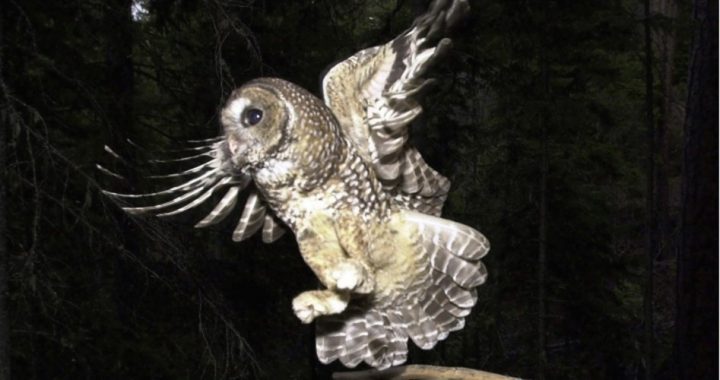
The Obama administration took advantage of the Thanksgiving weekend to give an early Christmas present to its “green” constituency: 9.6 million acres across the states of Washington, Oregon, and California. The ostensible recipient of this Black Friday gift is the Northern Spotted Owl, the raptor that has enraptured environmental activists and enraged loggers, ranchers, landowners, and rural towns that have been economically devastated by the “threatened” designation affixed to the bird by the U.S. Fish and Wildlife Service (FWS) under the Endangered Species Act (ESA). However, the real beneficiaries of the huge new lock-up of federal and state lands are not the iconic feathered mascots but the gold-plated activist organizations that lobbied, sued, and besieged the federal government to increase the protected spotted owl habitat from the already enormous 5.3 million acres designated by the Bush administration in 2008. Among those organizations are the American Bird Conservancy, the Center for Biological Diversity, EarthJustice, and the Sierra Club.
However, while celebrating the near doubling of the current spotted owl habitat, the green activists are far from satisfied. They are upset, first of all because they were hoping for an even bigger payoff. The Fish and Wildlife Service’s initial proposal in February contained 13.9 million acres of habitat, including 1.3 million acres of private land. Besides revising down the proposed increase, the current designation also excludes private land. In addition, the environmental groups are attacking the new forest plan’s concession to allow “active management,” i.e., controlled thinning and logging, in some of the designated habitat areas.
“Our concern is it’s giving a pretty broad license for on-the-ground management,” said Brett Hartl, senior policy fellow for the Society for Conservation Biology in Washington, D.C. The draft rule gave the BLM and Forest Service leeway to authorize logging projects that could harm the owl’s critical habitat, according to Hartl.
“They’ve never done this before in critical habitat, where they’ve had such detailed instructions to the agencies,” Hartl said. “It’s troublesome because that’s not the purpose of critical habitat under the ESA. Critical habitat is a mapping exercise primarily based on the conservation needs of the species.”
However, critics of the more than twenty years of failed practices in federal government’s Northwest Forest Plan, point out that it is piling folly upon folly to give the federal Forest Service and Bureau of Land Management even more land when the agencies’ own audits of their current holdings show massive mismanagement, neglect, and waste.
“To put it simply, the Northwest Forest Plan has failed,” declared Rep. Doc Hastings (R-Wash.), chairman of the House Committee on Natural Resources, at a hearing of the committee on May 21, 2012. “It has failed the health of national forests,” he continued. “It has failed the economic well-being of rural counties and schools, has cost tens of thousands of Northwest timber-related jobs and the closure of hundreds of mills and affected wood-products industries. And, it has failed to recover the Spotted Owl.”
Chairman Hastings noted further:
Nationwide, federal agencies are not managing the land they are required to manage. Amidst our nation’s current $15.7 trillion debt, the Interior Department’s and Forest Service’s own estimates reveal $22 billion in maintenance backlogs for lands managed by the Forest Service, Bureau of Land Management, U.S. Park Service and the U.S. Fish and Wildlife Service.
Worse, since the Northwest Forest Plan, an average of 355,000 acres per year of Northwest national forests has been destroyed by wildfire. Yet, agencies continue to request and spend more money to contain wildfires and acquire even more land.
In Washington, the Forest Service is already responsible for managing over 9 million acres of forest land contained within seven national forests. Timber harvests of those forests declined 84 percent over the past decade, resulting in a loss of jobs and economic certainty, and a breach of the federal government’s commitments to rural forest communities.
Rep. Hastings drew strong contrasts between the State of Washington’s management of its own state forests and the disastrous federal government practices. “The Forest Service harvests just 2 percent of new growth, yielding about $13 million in revenue,” he noted. “In contrast, the State of Washington, which manages in trust about one-fourth the amount of the Forest Service’s lands, produces seven times more revenue than the Forest Service for local governments, universities and state school construction.”
Rep. Hastings also charged that the habitat proposals “are based largely on outdated data from the 1990’s, don’t include an economic impact analysis, and do little, if anything, to immediately address the main cause of the owl’s decline: another predatory owl — the Barred Owl”
Owl vs. Owl
The Barred Owl? Most people have never heard of it, though nearly everyone has heard of the Spotted Owl. It turns out that the Barred Owl, the Spotted Owl’s major competitor, may be far more important in the Spotted Owl’s decline than the much-vilified loggers.
The original justification for putting millions of acres off-limits and bankrupting hundreds of rural communities in the process, recall, was that logging, especially of “old growth” forests, was destroying the habitat of the supposedly endangered Northern Spotted Owl. By closing the forests to logging, we would save this precious species, went the argument. That was the narrative in thousands of stories and impassioned demonstrations over the past two decades. But, according to the federal owl counters, the spotted owl has continued to decline, despite the drastic and economically ruinous closure of so many of our forests. Now, all these years later, many of the “experts” are admitting that the Barred Owl may be far more important in this equation than previously thought, even far more important than logging.
A February, 2012, U.S. Fish & Wildlife Service fact sheet on the Spotted Owl states:
Larger, more aggressive and more adaptable than the northern spotted owl, barred owls are known to displace spotted owls, disrupt their nesting and compete with them for food. Researchers have also observed instances of barred owls interbreeding with or killing spotted owls.
In a January, 2009 article, “The Spotted Owl’s New Nemesis,” Smithsonian magazine noted that, “nature has thrown the birds a curveball.” “A bigger, meaner bird — the barred owl — now drives spotted owls from their turf,” the Smithsonian reported. “Some scientists and wildlife managers have called for arming crews with decoys, shotguns and recorded bird songs in an experimental effort to lure barred owls from the trees and kill them.”
In March of this year, the Oregon office of the U.S. Fish & Wildlife Service came up with a number of options for “removing” Barred Owls, including one plan to kill up to 8,953 of the encroaching birds. The costs for the surveying, monitoring, and removal (whether lethal or non-lethal options are used) will, of course, run into the millions of dollars. And those costs will escalate, naturally, when “animal rights” activists decide that killing Barred Owls is unacceptable and mount disruptive protests and initiate court actions to stop the removal efforts.
But the Barred Owl vs. Spotted Owl battle does pose some interesting questions, such as: If we are going to take sides in battles over natural dominance between competing species, how far are we going to go? Who will make those decisions? And isn’t interfering in the owl vs. owl contest completely antithetical to the “let Nature take its course” doctrine manifested in the attitude of activists and the policies of federal agencies, for instance, when they advocate “protecting” forests against logging or other human activities, but accept far greater damage caused by catastrophic “natural” wild fires? And why interfere in the natural owl vs. owl match when insect infestation and “natural” wild fires (both dramatically increased by Forest Service “set aside” policies) kill more Spotted Owls and destroy more Spotted Owl habitat than logging and Barred Owls combined?
Oops! More Bogus “Science”
The Barred Owl predation discovery in the past few years is not the only fact to call into question the alleged science undergirding the federal government’s Spotted Owl policies. Indeed, it is but one of many.
In a public hearing on the proposed Northern Spotted Owl Critical Habitat Designation held in Portland, Oregon, on June 20, 2011, Ann Forest Burns, vice president of the American Forest Resource Council (AFRC) testified that “the proposed designation and the draft economic analysis are fatally flawed and would not pass muster under the statutory mandate provided by Congress in the Endangered Species Act.” Her testimony and more detailed subsequent comments by the AFRC point out that, among other things, the proposed habitat is fundamentally flawed through the use of faulty computer models rather than genuine science. The model used by the federal agencies, she notes, “does not depict what actual vegetative components exist on the ground but is rather a computer simulation of what might exist on the ground.”
As such, Burns testified, the model “creates a hypothetical landscape which is only useful for region wide, large scale, general planning level discussions and according to its creators should not be used ‘as input data for models that depend on local habitat connectivity, patch sizes, and structure,’ which is exactly how the USFWS used it.” However, according to Burns (and other experts), “Significant discrepancies exist between what is actually on the ground and the hypothetical vegetative layer” produced by the government’s computer model.
If the story has a ring of familiarity, it may be because the reader is recalling many similar stories over the past several years in which enviro-activists and government scientists have been exposed for colluding in doctoring evidence via computer modeling to generate public hysteria over global warming in order to gain adoption of their draconian legislation, regulations, and policies.
Computers can be useful, of course, for scientific calculations and simulations, but computer modeling cannot legitimately substitute for actual measurement, experimentation and observation. Yet that is not the only methodological flaw in the so-called “science” involving the Spotted Owl. In 2002, Federal Claims Court Judge Lawrence S. Margolis ruled in favor of the Wetsel-Oviatt Lumber Company in California and against the Forest Service for canceling timber sales in the name of protecting the Spotted Owl. In awarding Wetsel-Oviatt $9.5 million for canceled contracts, Judge Margolis charged that the Forest Service action was “arbitrary, capricious and without rational basis.” Moreover, said the judge, federal officials knew their actions were based on faulty science when they ordered the sale canceled.
“The Forest Service therefore breached its contractual obligation to fairly and honestly consider Wetsel’s bid on the sale,” Judge Margolis ruled. During the course of the trial the government’s expert witnesses were forced to admit that they had simply relied on satellite and aerial photography to identify “old-growth” trees, but had not done the proper ground inspections of the designated areas to determine if there were indeed Spotted Owl populations. Government ecologist Jo Ann Fites Kaufman admitted in court that her aerial-satellite method “probably wasn’t an appropriate method to use.” Owl “expert” Gerry Verner admitted that he had based much of his recommendation on canceling the timber contracts based on his strong “feeling” as he drove through the forest that it was Spotted Owl habitat, even though he had not actually found any specimens there. A government review of the science used to justify the timber contract cancellation conceded that the Forest Service analysis was unreliable.
The case of the Spotted Owl is far from the only instance of government agencies engaging in arbitrary, capricious, irrational, and fraudulent actions under the Endangered Species Act in pursuit of a “higher purpose.” Here are some of the more notorious examples, including even criminal actions and conspiracy:
Lynx lies — In 2002, a Forest Service investigation confirmed that seven government employees — three from the U.S. Forest Service, two from the U.S. Fish and Wildlife Service, and two from the Washington State Department of Fish and Wildlife — had planted five samples of Canadian lynx hair in the Wenatchee National Forest, the Mount Baker/Snoqualmie National Forest and the Gifford Pinchot National Forest. The false evidence of endangered lynx could have been used (and almost certainly would have been) to close vast areas of forestlands, if a fellow employee had not informed superiors concerning the criminal activity. Farming, ranching, logging, outfitting, and mining would have been hammered, along with public access to public lands for camping, hunting, fishing, skiing, snowmobiling, biking, hiking, and other recreational activities. Many livelihoods would have been ruined and many more lives adversely impacted, but the government agents who carried out this criminal conspiracy were not prosecuted; they were allowed to continue working and taking pay from the taxpayers and citizens they had schemed to defraud.
Loco on locoweed — In 2002, a federal judge ruling on a suit brought two years earlier by the Center for Biological Diversity, the Sierra Club, and Public Employees for Environmental Responsibility ordered the Bureau of Land Management to designate critical habitat for the “endangered” Peirson’s milk vetch in California’s Imperial Sand Dunes. Peirson’s milk vetch, which is more commonly known as “locoweed,” is a noxious, poisonous weed that farmers, ranchers and state, federal, and local agricultural agencies had been trying to eradicate for the past century. But, under the ESA it became protected and used by the government to close 48,000 acres of desert to dune buggying and other human activities.
Fishy business — In 2001, the USFWS, operating under a court order, stopped all use of irrigation water from Klamath Lake, for the supposed reason of protecting two bottom-feeding suckerfish. Hundreds of family farms and businesses in the Klamath Falls, Oregon, area were destroyed.
Fisheries biologist David A. Vogel, who testified before a Congressional hearing on the matter, stated that the Klamath farm situation is an “artificially created regulatory crisis that has been imposed on the Upper Klamath basin.” “In my entire professional career,” said Vogel, a fisheries scientist for 26 years including 15 years for the USFWS and the National Marine Fisheries Service, “I have never been involved in a decision-making process that was as closed, segregated, and poor as we now have in the Klamath basin. The constructive science-based processes I have been involved in elsewhere have involved an honest and open dialogue among people having scientific expertise. Hypotheses are developed, then rigorously tested against empirical evidence. None of those elements of good science characterize the decision-making process for the Klamath Project.” A committee appointed by the National Academy of Sciences agreed, reporting that “the committee finds no substantial scientific evidence supporting changes to the operating practices that have produced observed levels in Upper Klamath Lake and observed stream flows over the past 10 years.”
In his 2003 study, “The Problems with the Endangered Species Act,” Dr. Michael Coffman provides details on these issues of bogus science, criminal fraud, bureaucratic capriciousness, and economic devastation endemic under the Endangered Species Act. He also shows there are even weightier matters concerning constitutionality, usurpation, separation of powers, State sovereignty, and national sovereignty in the ESA process.
More extremism guaranteed under ESA
In his chairman’s statement during the May 21 hearing mentioned above, Rep. Doc Hastings noted there is “one constant” under the Endangered Species Act: “Extreme groups file lawsuit after lawsuit to block human or job-creating economic activity tied to the forests, yet the results are more catastrophic wildfires, more diseased and dying trees, and destruction of owl and species habitat.”
Photo of Northern Spotted Owl: AP Images
Related articles:
Obama Using “Endangered” Species to Kill Economy, Push Extreme Agenda



